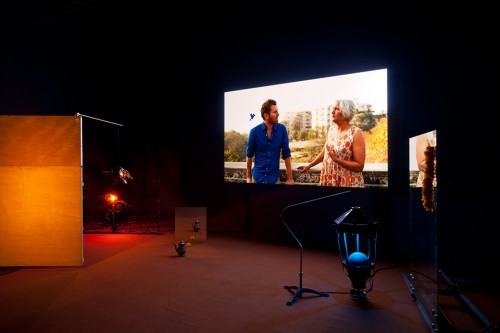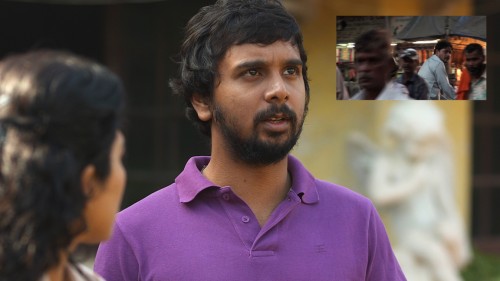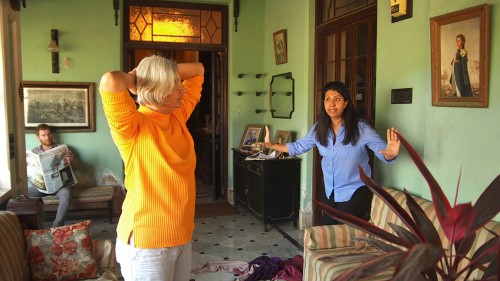
Vishal Jugdeo, Goods Carrier, 2012. Installation view by Brian Forrest. Courtesy the Hammer Museum.
Made in L.A., the Hammer Museum’s innaugural biennial of Los Angeles art, features work from 60 artists working in the city. Artist Vishal Jugdeo’s installation, Goods Carrier, pairs mechanical, TV set-like sculptures with an emotionally fraught 20-minute video set and shot in Mumbai, India. We spoke about transplanting his Los Angeles-centric art practice to a new, charged place, and the themes–new and old–that emerged as a result.
Lily Simonson: As with much of your work, the five characters in Goods Carrier enact a sort of nonlinear dialogue that evokes the domestic tension of familial or romantic relationships. Often, your dialogue seems to represent complex interpersonal dynamics while operating as a metaphor for global and political issues. Were you thinking about this consciously when writing Goods Carrier?
Vishal Jugdeo: When I’m writing the scripts for my videos, I think what I’m doing is experimenting with dialogic language rather than properly writing dialogue. I try to have the actors act things out in a realistic way, so that they’re transmitting real emotional states and putting themselves into tense exchanges with one another. At the same time, the words that they are saying is often, as you say, operating in a metaphorical or symbolic way. I’m interested in how the language itself breaks away from what is being acted out, and the words then take on a meaning of their own, unhinged from the drama that’s unfolding, but juxtaposed against it.
LS: I am specifically riveted by the way your work addresses arguing, and its surrounding awkwardness. At the same time, sweetness pervades. Do you see the conflict in your videos as being about increasing distance, or about resolving dissonance and becoming closer?
VJ: That’s a really interesting question. In my work I always see conflicts as intense acts of love. The characters never hate each other, they’re simply frustrated. And the words they are saying to one another often come from a place of deep fear, but also from a place of deep familiarity and intimacy. I’ve always thought of the works as “power plays” in a sense, and I think both words – power and play are key to understanding what I’m doing. It’s almost like practicing S&M through language alone or something, testing out what it is to say violent things, and to have violent things said to you. I hope that the charge that is transmitted to the viewer does have a kind of sweetness or warmth, which is why I use a lot of humor. I don’t want for someone to walk away feeling alienated, I want for them to feel an intense connection and even closeness to the work, even if that connection is uncomfortable or disconcerting.

Vishal Jugdeo. "Goods Carrier," 2012. Video still. Courtesy Hammer Museum.
LS: What inspired you to shoot Goods Carrier in India?
VJ: Prior to making Goods Carrier, all of my videos were filmed within the confines of my studio here in Los Angeles, in highly artificial sets that emphasized their remove from the “real world.” Those works are characterized by a sense of claustrophobia, where characters exist with one another within tightly compressed interior spaces, often making reference to an abstract “outside world,” but whenever that outside is shown, by a character looking out a window or through binoculars for example, it is revealed to be a simulated or artificial version of outside. I was interested in what would happen if I disengaged the work from the Beckett-like universe it lived in, and placed it in an almost realist setting. I had visited India several times growing up, and it always seemed to me to be an impossible place to make an abstract rendering of, which was really compelling to me. Also, because the earlier work was consciously engaging television in a way, and I was working with professionally trained actors here in LA, the work was operating within quite a specific vernacular of American culture, which I felt like I needed to break away from. I chose Mumbai in particular because it can be thought of as a parallel city to Los Angeles in that both are massive spectacle industries. I wanted to know which qualities of the work would translate easily, and which would become complicated by that shift.
LS: In some ways, by shooting in India, you were enacting the system of overseas “outsourcing.” Did that become part of the work? How did your own Indian heritage play into everything?
VJ: As I was conceiving of the work, I did think quite a bit about this idea of outsourcing, and in my work I was already investigating image production as a kind of economy. Initially I thought—quite naively—that the work would be cheaper to produce in India, and that it would be made in the same slapped-together, gerry-rigged fashion that construction and other processes of making seem to follow there, which felt similar to how I worked already. But as I started to put the shoot together, I quickly realized that I was wrong about that. In Los Angeles there is a culture of making films and television shows independently, for the web, etc, which is how I have been able to access these tools and processes cheaply. In Mumbai on the other hand, there doesn’t really exist an independent culture for image production, so everything follows the industry standards set out by Bollywood, commercials and television production. Equipment rental and professional services fees were more expensive than what I pay here in LA, and for the first time ever I needed to work with a producer, so that actually made this a more professional operation than I was used to. In the end I embraced the new conditions that I was having to work in, and I do feel like this work has a much different quality than my other work. Its surface is perhaps less awkward, and it starts to approach cinema, which is territory that I hadn’t really explored before.
I think the question of my own Indian heritage played in because I already had a sense of familiarity with the place and the culture. I knew that while I was ultimately an outsider there, my appearance and Indian name would give people a level of comfort in working with me that would make things easier. I don’t think this piece was about returning to my roots or something and yet that idea doesn’t seem as embarrassing to me as it once did….

Vishal Jugdeo. "Goods Carrier," 2012. Video still. Courtesy Hammer Museum.
LS: How did the interposing of your partner–the red-headed, very pale Billy–among Indian natives speak to these themes? Do you think about class? Is there still a relationship between class and skin tone in India?
VJ: I wanted Billy to kind of float in and out of the scenes, without much explanation as to why he was there. Of course, he has become something of a central subject in my work, as he has appeared in several of my videos. But apart from that I was interested in how his appearance in scenes instantly makes the viewer aware of their own position outside the image. I like that he sticks out like a sore thumb in those scenes; he is the “alien.” It was interesting to me that in those moments, the viewer is reminded of their own position outside of the image. I’m speaking of course of a western viewer. I am trying to show this work in Mumbai next year, and I’m interested in how that sense of the outsider will resonate when it’s seen there.
I do think about class a lot, and while it’s not explicitly made reference to, it forms the backdrop for the work. The four Indian characters are playing out an image of privilege. Not only is this made evident by the colonial era mansion in which the video is set, complete with Dutch still-life paintings and pictures of the queen, but their behavior is particularly upper-middle class, the fact that they speak in English, and most importantly that they are relating to each other as though they are inside of a family melodrama: they are enacting emotional states in a particularly “western” way. And yes, there is a relationship between class and skin tone in India, and if we were reading the image as realism, then the idea of having a white American friend visit the house would instantly denote something about the mobility of this group of people.
LS: While the exposed sets were absent from the video itself, they did make their way into the installation. Can you talk about the mechanical sculptural elements in the piece? Can you talk about the relationship between video and sculpture?
I sort of think of the sculptural elements and the projected image in Goods Carrier as operating in two separate universes. The mechanical parts act as parentheses around the filmed sequences, and are activated at moments when I felt as though I needed to physically pull the viewer out of the image, and back into the space of the here and now, if that makes sense. For me it’s about positioning the viewer in relation to the image, so that the image is just a window or a picture, and the viewer exists in her own reality, looking out. That tension is something that I have worked with for years, and yet it’s the part of my work that I find the most difficult to explain. I think it has to do with trying to activate parts of the psyche that are difficult to access, and there is something about that space between the cerebral and the sensual that seems, at this moment in history, especially important to explore.

Vishal Jugdeo. "Goods Carrier," 2012. Photo of installation view by Brian Forrest. Courtesy Hammer Museum.



